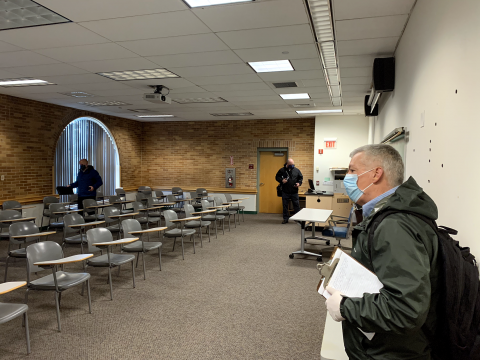
Marshall White, the new ET&S director for learning and collaboration space technology, surveys a classroom at Keene State College as part of the Zoom-capable classroom project.
Technology upgraded 193 classrooms across the University System of New Hampshire (USNH) institutions over the summer of 2020, adding flexibility for students and faculty in response to the coronavirus pandemic. Enterprise Technology & Services (ET&S) audio-visual services staff partnered with local vendors to engineer and transform a number of classrooms into "Zoom-capable" teaching and learning spaces.
The two-phase project involved the design and installation of high-tech audio and video systems that allowed students to either attend classes in person or remotely, while also providing faculty the flexibility of teaching from home.
In phase one, ET&S upgraded 25% of all classrooms at each campus by mid-August 2020. Phase two involved a much more aggressive approach that saw 50% of all USNH classrooms upgraded with new Zoom functionality. All told, ET&S upgraded 193 classrooms.
In early May 2020, a team comprising USNH AV staff and outside technicians visited all perspective sites across the state to gauge the work ahead. Marshall White, the new ET&S director for learning and collaboration space technology, is leading the team.
"This project had an aggressive timeline and where we would normally meet with faculty and future users of the classrooms to analyze needs, engage in a conversation about use cases, we simply don't have time," White said. "We designed this upgrade to provide a high-quality experience for students or faculty participating from home or the classroom, while also keeping the design simple and repeatable."
Technicians fitted each Zoom-enabled room with state-of-the-art equipment. A camera at the back of the room automatically detects the instructor's face and follows them whenever they move. A second camera in the front captures students sitting in class.
Intelligent microphones mounted in the ceilings pick up audio as it is produced, providing a live feel for remote viewers. Confidence monitors installed at the rear of each classroom show the "Brady Bunch" web conference grid, helping instructors know they are connected.
While the visual component of Zoom-capable classrooms is important, capturing good audio is a more significant challenge. Large lecture halls are typically echoey and hard to master when it comes to sound. With this in mind, classrooms selected for the upgrades have a capacity of 60 people, ensuring better quality audio. Classrooms historically with the highest utilization were also prioritized.
Outside of asynchronous instruction, faculty are able to use these classrooms to record lectures that can later be used in a flipped-classroom scenario, where students first watch pre-recorded videos at home filmed prior to class and then tackle the assignments in class with the background knowledge provided by the content. The Zoom-capable rooms also make it easier to bring in guest speakers from across the globe. Students, faculty and staff also can reserve these classrooms for special events requiring high-quality web conferencing.
This project wasn't without its share of challenges: the schedule was ambitious; product availability was an issue; standardizing to one specification that worked well for all classrooms was difficult. But the project's benefits outweigh the risks.
"USNH institutions want to provide safe and engaging learning environments for students, and students want to be back on campus," White said. "Providing these rooms gives students and faculty additional options if one or many should be in quarantine.”


